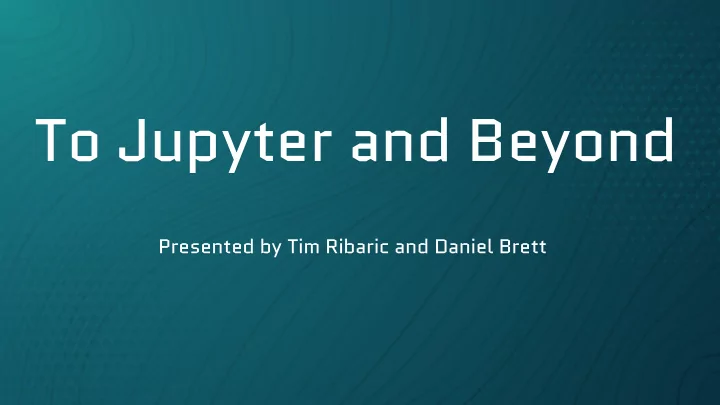

To Jupyter and Beyond Presented by Tim Ribaric and Daniel Brett
First, a commercial! 2
Agenda What is a computational notebook? Typical Use Cases How to get and use Jupyter? Live Demo Questions / Comments? 3
What is a Computational Notebook? Have you heard this phrase before?
What a Computational Notebook Is First introduced in 1988 with Wolfram Mathematica, followed closely by Maple in 1989 You can think of them as an analogue to the notebook a scientist would keep track of their experiments and finds with 5
How it works It is a virtual notebook environment used for something referred to as Li Liter erate e programming Basically it pairs word processing with two things called a shell and a kernel 6
What it looks like A webpage with a bunch of text boxes on it! Text boxes are referred to as cells Cell come in two types: Code Markdown 7
Cells - Markdown A syntax that makes HTML 8
Cells - Code This is the computer code Simple! 9
“ That's pretty much it! 10
How are they being used today?
Repeatable Research 12
Repeatable Research Cont. https://www.sciencemag.org/news/2016/04/whos-downloading-pirated-papers-everyone 13
In the DSL TWARC tool to harvest tweets that include #datavisualization Ran text processing on the data in a Jupyter Notebook using R Finally, we fed the cleaned text to Voyant to produce a word cloud 14
Use for tutorials Low overhead for users. (Nothing to install) At the DSL we use Jupyter Notebooks to contain our tutorials that use Python or R code Our Python 2.0 workshop comes with a Jupyter Notebook that learners can run through https://brockdsl.github.io/Python_2.0_Workshop/ 15
Netflix Integral part of their Data Platform since 2017 “The most popular tool for working with data at Netflix” (Netflix TechBlog, 2018) Use for creating reusable templates for frequent tasks And much more! https://netflixtechblog.com/notebook-innovation-591ee3221233 16
Kaggle Great source of free datasets Hub where Jupyter Notebooks containing all kinds of projects and code are shared freely High profile coding competitions with Jupyter Notebooks as the preferred submission method. Competitions range from Passenger Screening Algorithm Challenges to solving Santa's workshop efficiency problems 17
How do we get to Jupyter?
My Binder A tool that turns a repository of Jupyter Notebooks on GitHub into a clean, web accessible interface. Allows you to share Jupyter Notebooks with others without them needing Jupyter on their computers. https://mybinder.org/ 19
ArcGIS Notebooks Allows you to build and run Notebooks that are connected to all of you Arc resources and your ArcGIS Online storage space. Gives access to repeatable ArcGIS functions and mapping tools from within the notebook. https://www.esri.com/arcgis-blog/products/arcgis- enterprise/analytics/introducing-arcgis-notebooks/ 20
Syzygy – Via Compute Canada A Jupyter environment accessible on the web that uses your existing single-sign-on system to allow access Hosted by Compute Canada and Cybera Only for Universities unfortunately https://syzygy.ca/ 21
Desktop Version via Anaconda A Desktop version of Jupyter is available through a free distribution software called Anaconda Package of statistical and mathematical tools useful for many things All free https://www.anaconda.com 22
Live Demo
Questions / Comments?
Credits dsl@brocku.ca Tim Ribaric http://brocku.ca/library/dsl tribaric@brocku.ca @elibtronic Presentation template by SlidesCarnival Daniel Brett dbrett@brocku.ca 25
Recommend
More recommend